简介
建议先看下前文 Kubernetes源码分析——从kubectl开始
笔者不太喜欢抠细节,加上k8s 没有使用 uber-go/dig 之类的依赖注入库(很多代码 搞到最后就是 spring ioc干的活儿,但一换go的马甲,经常一下子没看出来),struct 组合代码 和 struct 行为代码耦合在一起,本文主要关注 行为代码。笔者认为,关键不是一些结构体定义, 而是业务逻辑:怎么启动了一个pod?怎么管理pod 的等?与cni、csi 插件怎么结合?如何与docker 协同?
背景知识
- 一个grpc client 和 server 如何实现
- spf13/cobra
- go 运行可执行文件
整体结构
《深入剖析Kubernetes》:kubelet 调用下层容器运行时的执行过程,并不会直接调用Docker 的 API,而是通过一组叫作 CRI(Container Runtime Interface,容器运行时接口)的 gRPC 接口来间接执行的。Kubernetes 项目之所以要在 kubelet 中引入这样一层单独的抽象,当然是为了对 Kubernetes 屏蔽下层容器运行时的差异。实际上,对于 1.6 版本之前的 Kubernetes 来说,它就是直接调用 Docker 的 API 来创建和管理容器的。
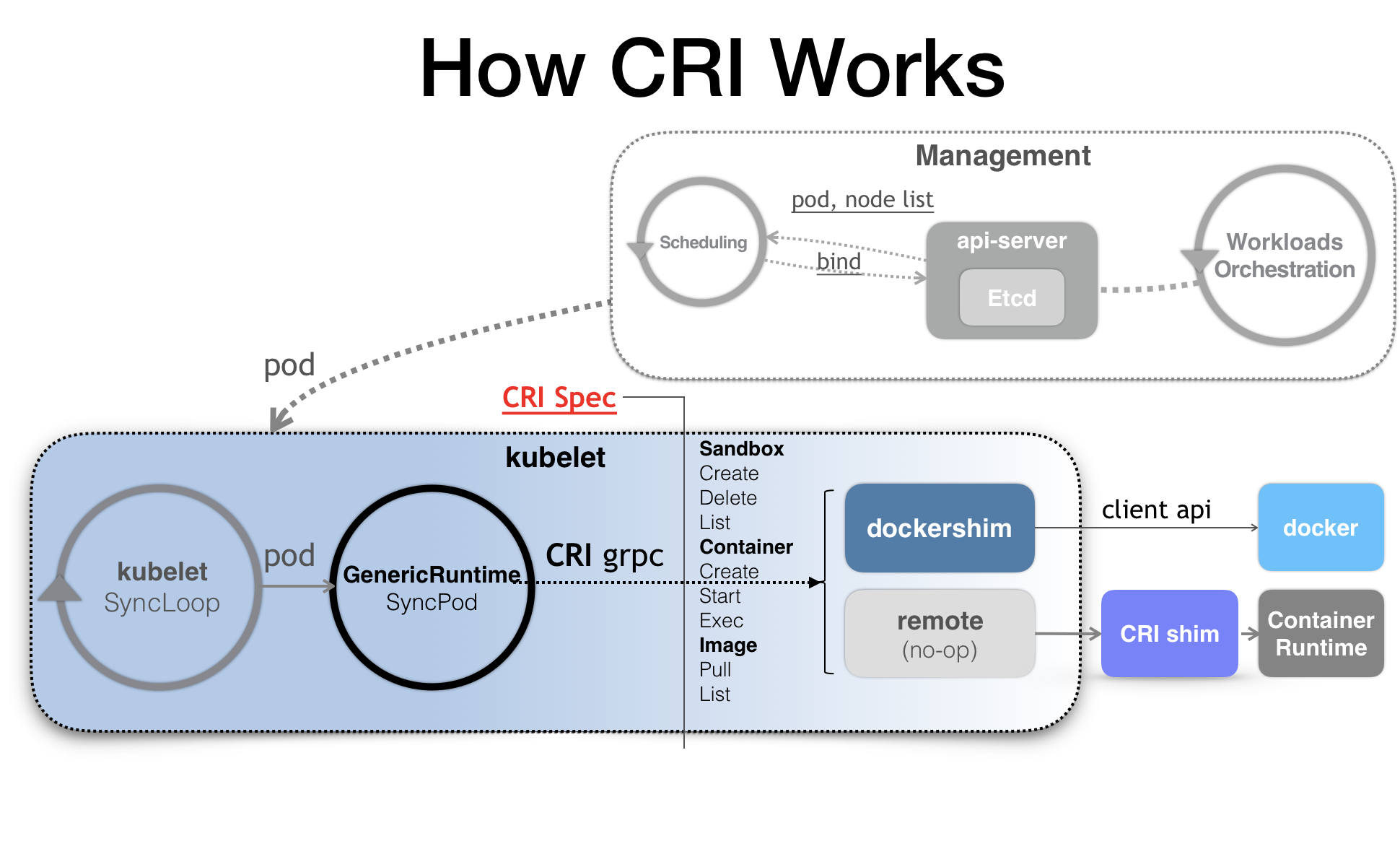
除了 dockershim 之外,其他容器运行时的 CRI shim,都是需要额外部署在宿主机上的。
go 里面没有 extends、implements 这些关键字,我们要把struct、interface重建起来
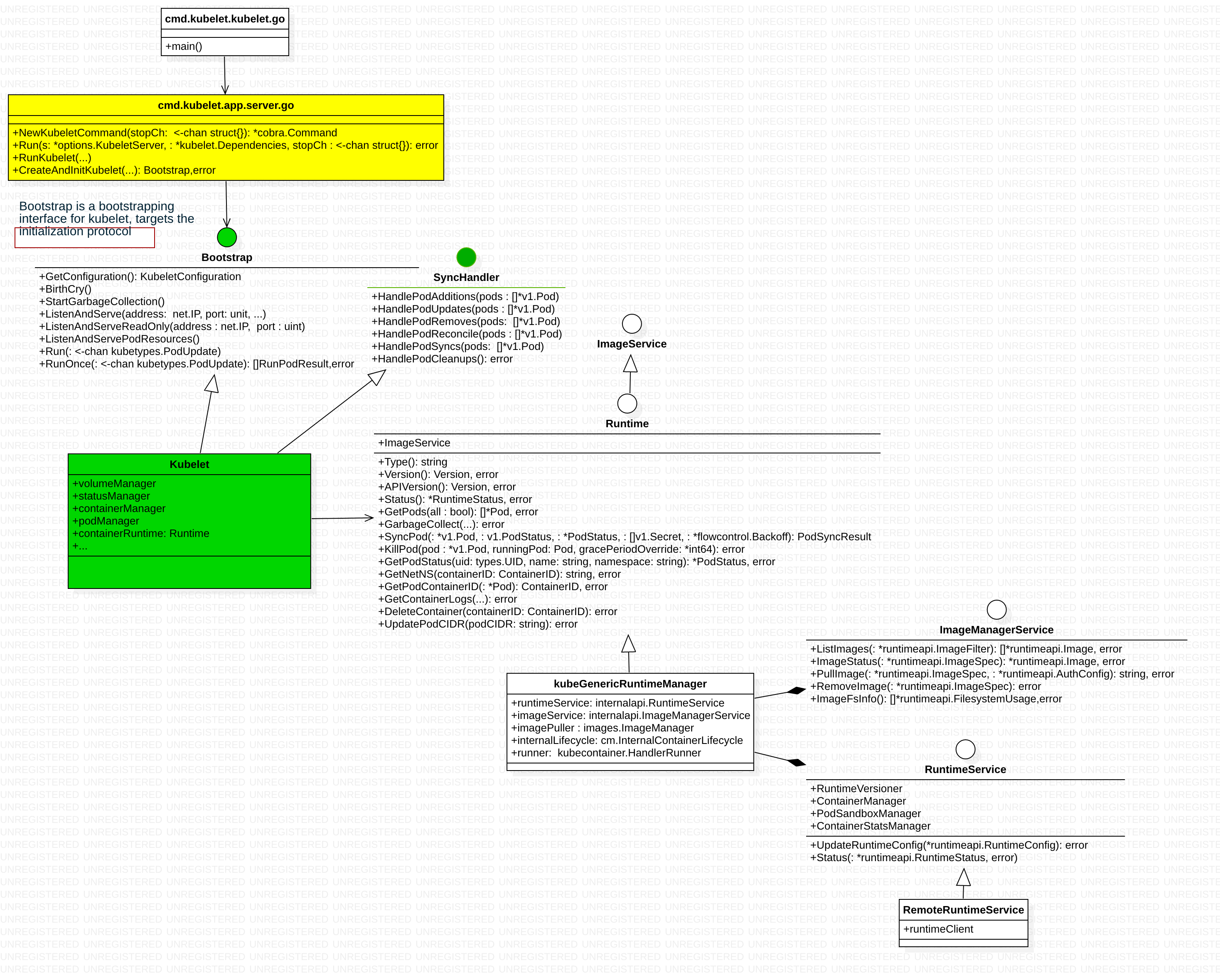
上图左中右,像极了spring mvc的controller-service-rpc,一层一层的 将高层概念/动作 分解为 cri 提供的基本概念/底层操作。
| spring mvc | kubelet | kubelet 所在包 | 概念 |
|---|---|---|---|
| controller | kubelet struct | pkg/kubelet/kubelet.go |
|
| service | Runtime interface | pkg/kubelet/container |
Pod/PodStatus/Container/ContainerStatus/Image Mount/PortMapping/VolumeInfo/RunContainerOptions |
| service.impl | kubeGenericRuntimeManager struct | pkg/kubelet/kuberuntime |
|
| rpc | RuntimeService interface/ImageManagerService interface | pkg/kubelet/apis/cri |
Container/PodSandbox/Image/AuthConfig |
| rpc.impl | RemoteRuntimeService struct | pkg/kubelet/apis/remote |
启动流程
几个感觉:
- 配置 spf13/cobra,并从命令行中获取各种参数,封装为KubeletServer(就是个 配置参数的struct) 和kubelet.Dependencies 然后开始run
- cmd/kubelet 和 pkg/kubelet 边界在哪?
- kubelet struct 就是一个大controller,依赖各种对象,有一个对它进行配置 和初始化的过程,
-
kubelet 是一个命令行方式启动的 http server,内有有一些“线程”
- 监听pod/接收指令,然后做出反应
- 向api server 汇报数据
Kubelet 源码剖析 有一个启动的序列图
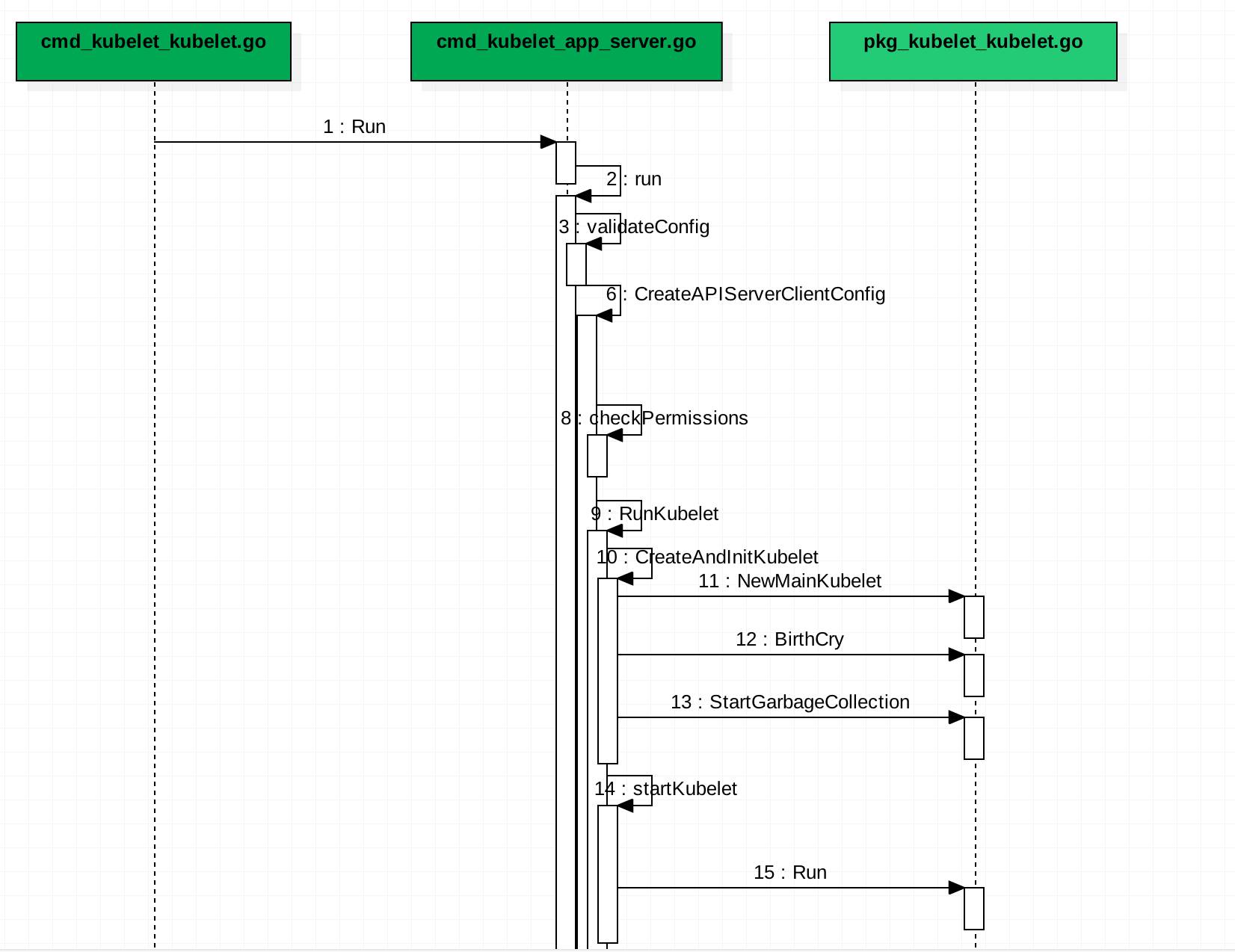
比较有意思的是 Bootstap interface 的描述:Bootstrap is a bootstrapping interface for kubelet, targets the initialization protocol. 也就是 cmd/kubelet 和 pkg/kubelet 的边界是 Bootstap interface
kubelet 启动逻辑, 启动一堆线程,然后开启一个syncLoop
// Run starts the kubelet reacting to config updates
func (kl *Kubelet) Run(updates <-chan kubetypes.PodUpdate) {
...
// Start the cloud provider sync manager
go kl.cloudResourceSyncManager.Run(wait.NeverStop)
// Start volume manager
go kl.volumeManager.Run(kl.sourcesReady, wait.NeverStop)
// Start syncing node status immediately, this may set up things the runtime needs to run.
go wait.Until(kl.syncNodeStatus, kl.nodeStatusUpdateFrequency, wait.NeverStop)
go kl.fastStatusUpdateOnce()
// start syncing lease
go kl.nodeLeaseController.Run(wait.NeverStop)
go wait.Until(kl.updateRuntimeUp, 5*time.Second, wait.NeverStop)
// Start loop to sync iptables util rules
go wait.Until(kl.syncNetworkUtil, 1*time.Minute, wait.NeverStop)
// Start a goroutine responsible for killing pods (that are not properly handled by pod workers).
go wait.Until(kl.podKiller, 1*time.Second, wait.NeverStop)
// Start component sync loops.
kl.statusManager.Start()
kl.probeManager.Start()
// Start syncing RuntimeClasses if enabled.
go kl.runtimeClassManager.Run(wait.NeverStop)
// Start the pod lifecycle event generator.
kl.pleg.Start()
kl.syncLoop(updates, kl)
}
复杂的程序,一定使用面向对象思想写的(函数式编程简化了一部分逻辑)
syncLoop
syncLoop is the main loop for processing changes. It watches for changes from three channels (file, apiserver, and http) and creates a union of them. For any new change seen, will run a sync against desired state and running state. If no changes are seen to the configuration, will synchronize the last known desired state every sync-frequency seconds. Never returns.
func (kl *Kubelet) syncLoop(updates <-chan kubetypes.PodUpdate, handler SyncHandler) {
// 准备工作
for{
time.Sleep(duration)
kl.syncLoopIteration(...)
...
}
}
syncLoopIteration 接收来自多个方向的消息,run a sync against desired state and running state
func (kl *Kubelet) syncLoopIteration(configCh <-chan kubetypes.PodUpdate, handler SyncHandler,
syncCh <-chan time.Time, housekeepingCh <-chan time.Time, plegCh <-chan *pleg.PodLifecycleEvent) bool {
select {
case u, open := <-configCh:
case e := <-plegCh:...
case <-syncCh:...
case update := <-kl.livenessManager.Updates():...
case <-housekeepingCh:...
}
return true
}
syncLoopIteration reads from various channels and dispatches pods to the given handler. 以configCh 为例
switch u.Op {
case kubetypes.ADD:
handler.HandlePodAdditions(u.Pods)
case kubetypes.UPDATE:
handler.HandlePodUpdates(u.Pods)
case kubetypes.REMOVE:
handler.HandlePodRemoves(u.Pods)
case kubetypes.RECONCILE:
handler.HandlePodReconcile(u.Pods)
case kubetypes.DELETE:
// DELETE is treated as a UPDATE because of graceful deletion.
handler.HandlePodUpdates(u.Pods)
case kubetypes.RESTORE:
// These are pods restored from the checkpoint. Treat them as new pods.
handler.HandlePodAdditions(u.Pods)
}
最终的立足点还是 syncHandler(还是Kubelet 自己实现的),下面分析下 HandlePodAdditions
新建 pod
代码中去掉了跟创建 无关的部分,删减了日志、错误校验等
func (kl *Kubelet) HandlePodAdditions(pods []*v1.Pod) {
sort.Sort(sliceutils.PodsByCreationTime(pods))
for _, pod := range pods {
...
// Always add the pod to the pod manager. Kubelet relies on the pod manager as the source of truth for the desired state. If a pod does
// not exist in the pod manager, it means that it has been deleted in the apiserver and no action (other than cleanup) is required.
kl.podManager.AddPod(pod)
...
mirrorPod, _ := kl.podManager.GetMirrorPodByPod(pod)
kl.dispatchWork(pod, kubetypes.SyncPodCreate, mirrorPod, start)
kl.probeManager.AddPod(pod)
}
}
kl.podManager.AddPod 和 kl.probeManager.AddPod(pod) 都只是将pod 纳入跟踪,真正创建pod的是dispatchWork,然后又转回 kl.syncPod
func (kl *Kubelet) syncPod(o syncPodOptions) error {
...
// Generate final API pod status with pod and status manager status
apiPodStatus := kl.generateAPIPodStatus(pod, podStatus)
existingStatus, ok := kl.statusManager.GetPodStatus(pod.UID)
if runnable := kl.canRunPod(pod); !runnable.Admit {...}
// Update status in the status manager
kl.statusManager.SetPodStatus(pod, apiPodStatus)
// Create Cgroups for the pod and apply resource parameters to them if cgroups-per-qos flag is enabled.
pcm := kl.containerManager.NewPodContainerManager()
// Make data directories for the pod
kl.makePodDataDirs(pod);
// Fetch the pull secrets for the pod
pullSecrets := kl.getPullSecretsForPod(pod)
// Call the container runtime's SyncPod callback
result := kl.containerRuntime.SyncPod(pod, apiPodStatus, podStatus, pullSecrets, kl.backOff)
...
}
kubeGenericRuntimeManager.syncPod
func (m *kubeGenericRuntimeManager) SyncPod(pod *v1.Pod, _ v1.PodStatus, podStatus *kubecontainer.PodStatus, pullSecrets []v1.Secret, backOff *flowcontrol.Backoff) (result kubecontainer.PodSyncResult) {
// Step 1: Compute sandbox and container changes.
podContainerChanges := m.computePodActions(pod, podStatus)
...
// Step 4: Create a sandbox for the pod if necessary.
podSandboxID, msg, err = m.createPodSandbox(pod, podContainerChanges.Attempt)
// Get podSandboxConfig for containers to start.
podSandboxConfig, err := m.generatePodSandboxConfig(pod, podContainerChanges.Attempt)
// Step 5: start the init container.
if container := podContainerChanges.NextInitContainerToStart; container != nil {
// Start the next init container.
msg, err := m.startContainer(podSandboxID, podSandboxConfig, container, pod, podStatus, pullSecrets, podIP, kubecontainer.ContainerTypeInit);
}
// Step 6: start containers in podContainerChanges.ContainersToStart.
for _, idx := range podContainerChanges.ContainersToStart {
container := &pod.Spec.Containers[idx]
msg, err := m.startContainer(podSandboxID, podSandboxConfig, container, pod, podStatus, pullSecrets, podIP, kubecontainer.ContainerTypeRegular);
}
...
}
m.createPodSandbox 和 startContainer
pkg/kubelet/kuberuntime/包中,kuberuntime_manager.go 定义了 kubeGenericRuntimeManager struct 及其接口方法实现,但接口方法的内部依赖方法 分散在 package 下的其它go文件中。其本质是将 一个“类方法”分散在了多个go 文件中,多个文件合起来 组成了kubeGenericRuntimeManager 类实现。
| 文件 | 方法 | 备注 |
|---|---|---|
| kuberuntime_manager.go | NewKubeGenericRuntimeManager/GetPods/SyncPod/KillPod/GetPodStatus etc | |
| kuberuntime_sandbox.go | createPodSandbox | |
| kuberuntime_container.go | startContainer | |
| kuberuntime_image.go | PullImage |
func (m *kubeGenericRuntimeManager) startContainer(podSandboxID string, podSandboxConfig *runtimeapi.PodSandboxConfig, container *v1.Container, pod *v1.Pod, podStatus *kubecontainer.PodStatus, pullSecrets []v1.Secret, podIP string, containerType kubecontainer.ContainerType) (string, error) {
// Step 1: pull the image.
imageRef, msg, err := m.imagePuller.EnsureImageExists(pod, container, pullSecrets)
// Step 2: create the container.
ref, err := kubecontainer.GenerateContainerRef(pod, container)
containerConfig, cleanupAction, err := m.generateContainerConfig(container, pod, restartCount, podIP, imageRef, containerType)
containerID, err := m.runtimeService.CreateContainer(podSandboxID, containerConfig, podSandboxConfig)
err = m.internalLifecycle.PreStartContainer(pod, container, containerID)
// Step 3: start the container.
err = m.runtimeService.StartContainer(containerID)
// Step 4: execute the post start hook.
msg, handlerErr := m.runner.Run(kubeContainerID, pod, container, container.Lifecycle.PostStart)
}
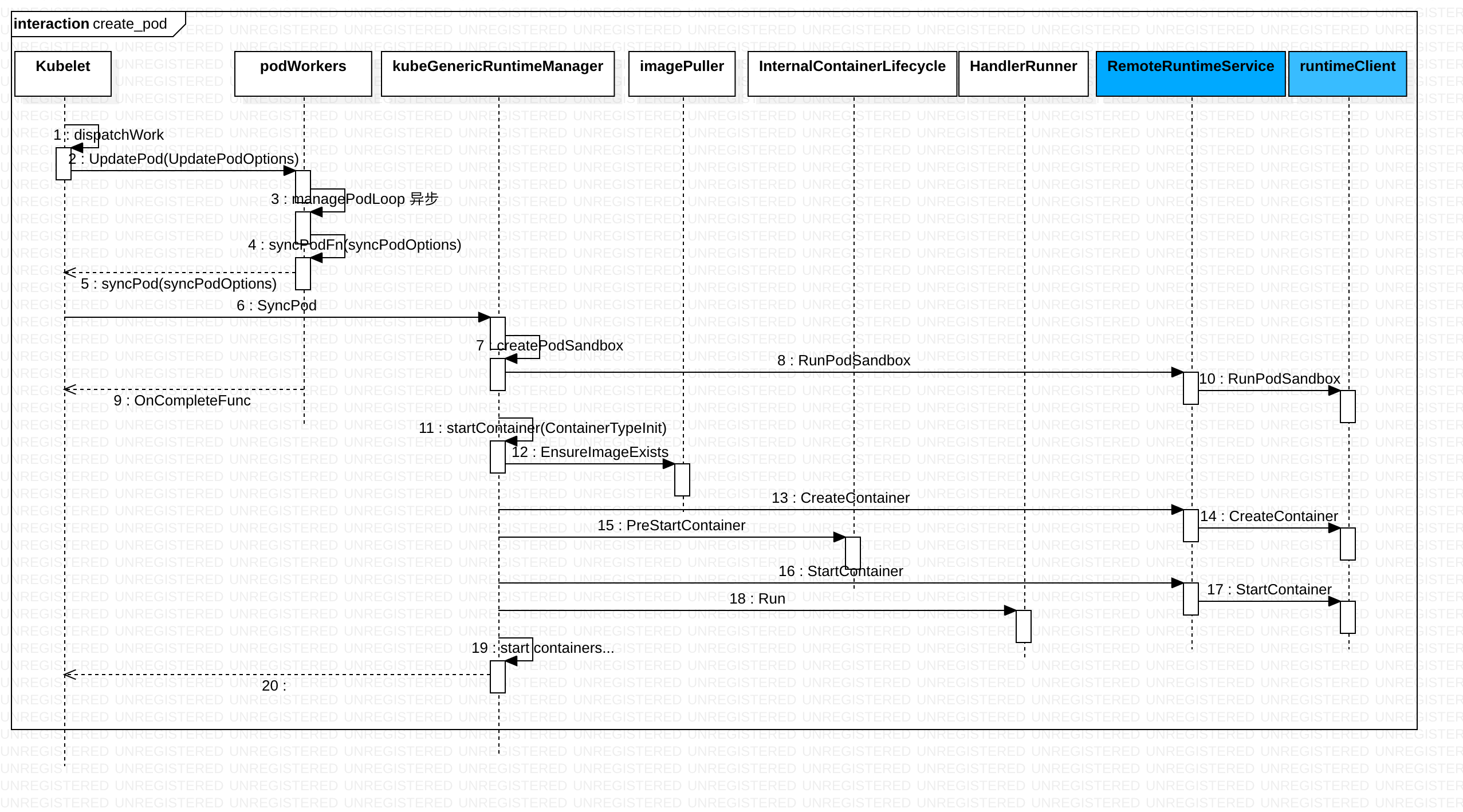
从图中可以看到,蓝色区域 grpc 调用 dockershim等cri shim 完成。笔者java 开发出身,上诉代码 换成spring mvc 就很好理解:从请求到实际的底层接口,将抽象的概念展开,中间经常涉及到model的转换
dockershim
在 Kubernetes 中,处理容器网络相关的逻辑并不会在kubelet 主干代码里执行,而是会在具体的 CRI(Container Runtime Interface,容器运行时接口)实现里完成。对于 Docker 项目来说,它的 CRI 实现叫作 dockershim,相关代码在 pkg/kubelet/dockershim 下
CRI 设计的一个重要原则,就是确保这个接口本身只关注容器, 不关注Pod。但CRI 里有一个PodSandbox,抽取了Pod里的一部分与容器运行时相关的字段,比如Hostname、DnsConfig等。作为具体的容器项目,自己决定如何使用这些字段来实现一个k8s期望的Pod模型。

kubelet中调用CRI shim提供的imageService,ContainerService接口,作为gRPC client,dockershim实现了CRI gRPC Server服务端的服务实现,但是dockershim仍然整合到了kubelet中,作为kubelet默认的CRI shim实现.所以说,要了解这块得先熟悉 一个grpc client 和 server 如何实现
dockershim 封了一个pkg/kubelet/dockershim/libdocker 会使用docker提供的client来调用cli接口,没错!就是github.com/docker/docker/client
顺着上文思路,当 kubelet 组件需要创建 Pod 的时候,它第一个创建的一定是 Infra 容器,这体现在上图的 RunPodSandbox 中
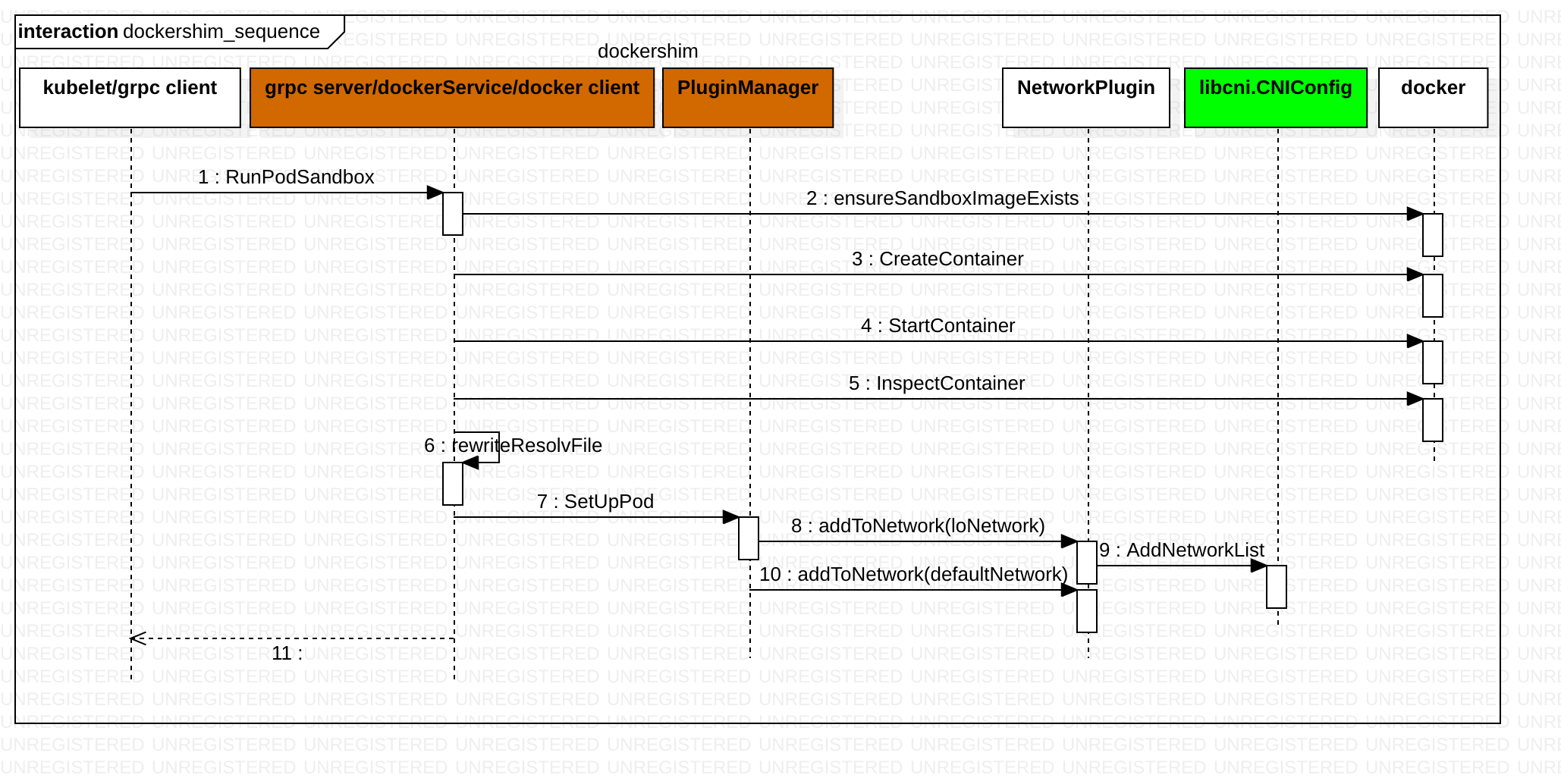
RunPodSandbox creates and starts a pod-level sandbox. Runtimes should ensure the sandbox is in ready state.For docker, PodSandbox is implemented by a container holding the network namespace for the pod.Note: docker doesn’t use LogDirectory (yet).
func (ds *dockerService) RunPodSandbox(ctx context.Context, r *runtimeapi.RunPodSandboxRequest) (*runtimeapi.RunPodSandboxResponse, error) {
config := r.GetConfig()
// Step 1: Pull the image for the sandbox.
err := ensureSandboxImageExists(ds.client, defaultSandboxImage);
// Step 2: Create the sandbox container.
createConfig, err := ds.makeSandboxDockerConfig(config, image)
createResp, err := ds.client.CreateContainer(*createConfig)
ds.setNetworkReady(createResp.ID, false)
defer func(e *error) {
// Set networking ready depending on the error return of the parent function
if *e == nil {
ds.setNetworkReady(createResp.ID, true)
}
}(&err)
// Step 3: Create Sandbox Checkpoint.
ds.checkpointManager.CreateCheckpoint(createResp.ID, constructPodSandboxCheckpoint(config));
// Step 4: Start the sandbox container. Assume kubelet's garbage collector would remove the sandbox later, if startContainer failed.
err = ds.client.StartContainer(createResp.ID)
// Rewrite resolv.conf file generated by docker.
containerInfo, err := ds.client.InspectContainer(createResp.ID)
err := rewriteResolvFile(containerInfo.ResolvConfPath, dnsConfig.Servers, dnsConfig.Searches, dnsConfig.Options);
// Do not invoke network plugins if in hostNetwork mode.
if config.GetLinux().GetSecurityContext().GetNamespaceOptions().GetNetwork() == runtimeapi.NamespaceMode_NODE {
return resp, nil
}
// Step 5: Setup networking for the sandbox.
// All pod networking is setup by a CNI plugin discovered at startup time. This plugin assigns the pod ip, sets up routes inside the sandbox,
// creates interfaces etc. In theory, its jurisdiction ends with pod sandbox networking, but it might insert iptables rules or open ports
// on the host as well, to satisfy parts of the pod spec that aren't recognized by the CNI standard yet.
err = ds.network.SetUpPod(config.GetMetadata().Namespace, config.GetMetadata().Name, cID, config.Annotations, networkOptions)
return resp, nil
}
与 kubeGenericRuntimeManager 类似,dockerService 方法分散在各个文件中
| go文件 | 包含方法 |
|---|---|
| docker_service.go | dockerService struct 定义 以及GetNetNS/Start/Status等 |
| docker_sandbox.go | RunPodSandbox等 |
| docker_container.go | CreateContainer/StartContainer等 |
| docker_image.go | PullImage等 |
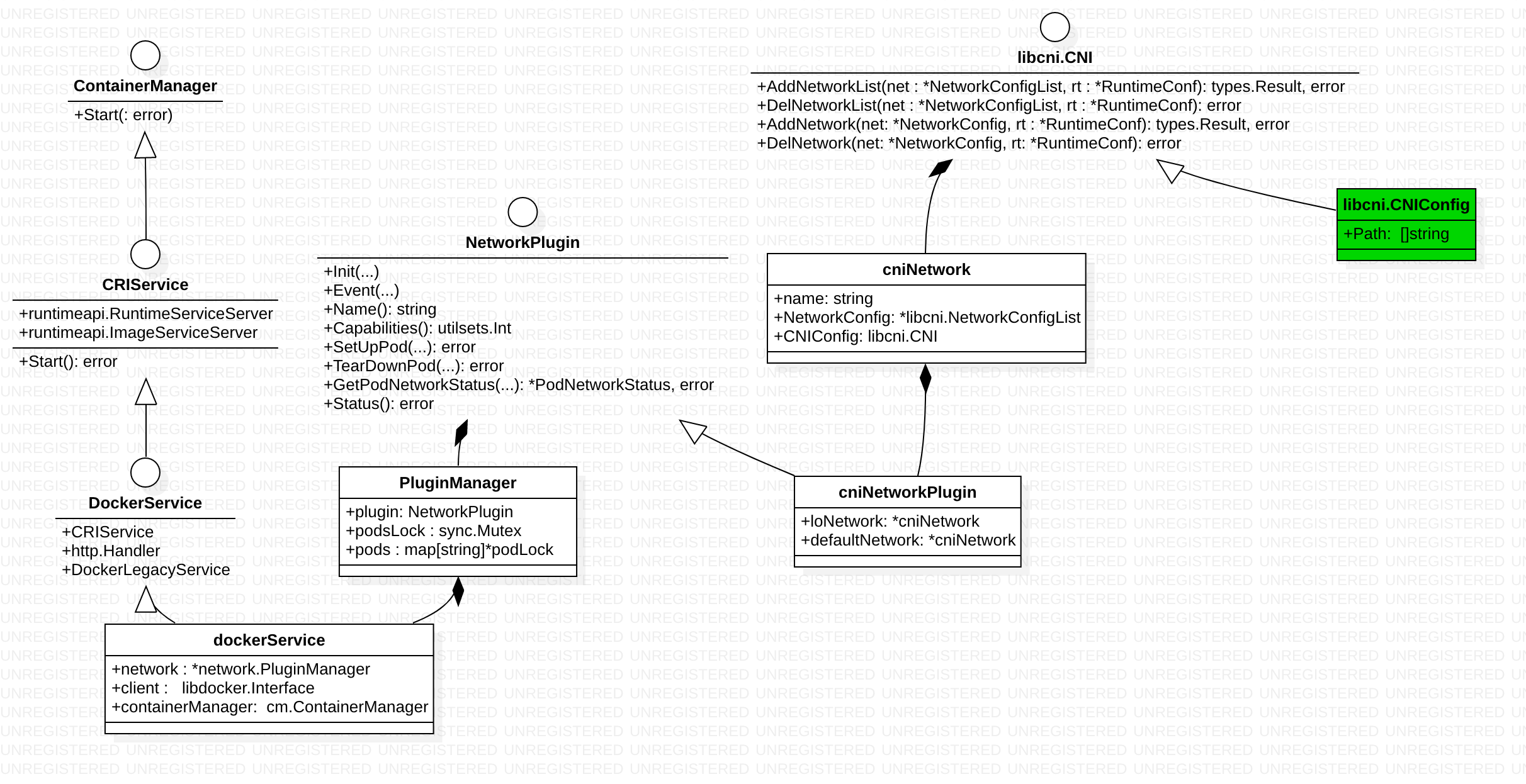
从左到右可以看到用户请求 怎么跟cni plugin(binary file) 产生关联的
golang中一个接口可以包含一个或多个其他的接口,这相当于直接将这些内嵌接口的方法列举在外层接口中一样。
加载 CNI plugin
建议参看《Container-Networking-Docker-Kubernetes》笔记了解下CNI 的相关概念及使用。
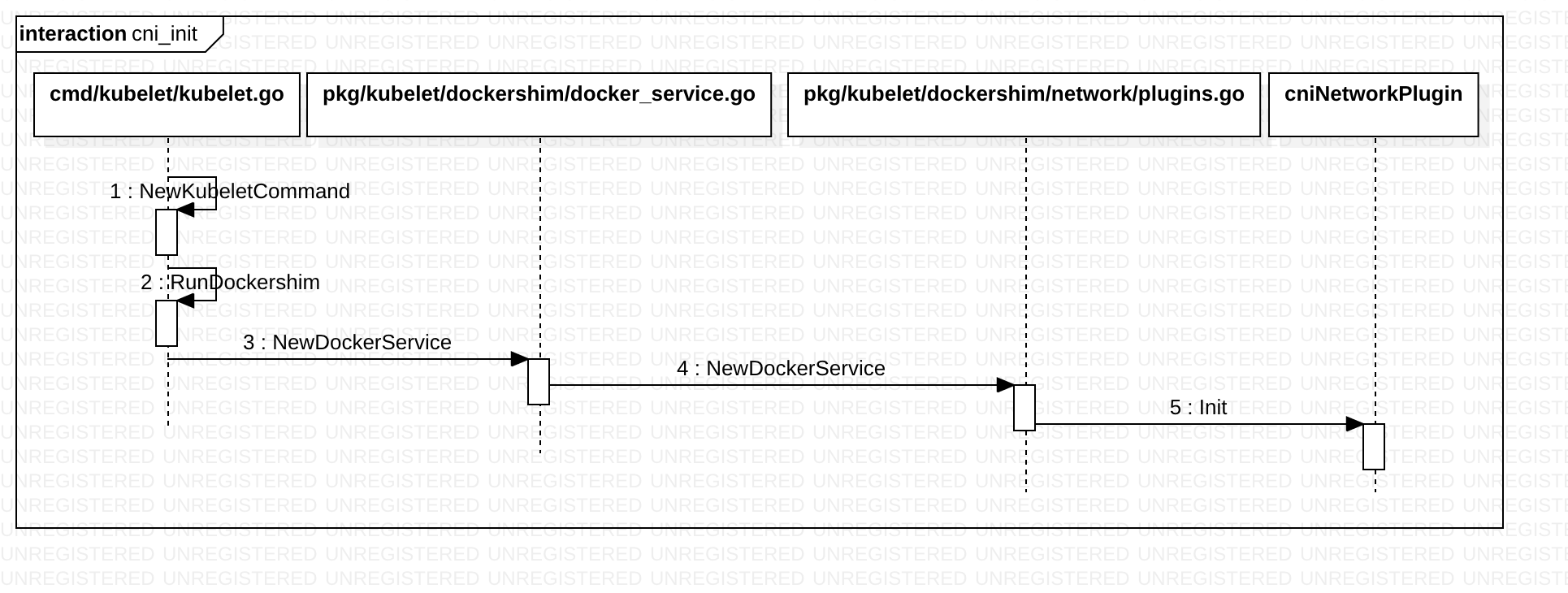
cniNetworkPlugin.Init 方法逻辑如下
func (plugin *cniNetworkPlugin) Init(host network.Host, hairpinMode kubeletconfig.HairpinMode, nonMasqueradeCIDR string, mtu int) error {
err := plugin.platformInit()
...
plugin.host = host
plugin.syncNetworkConfig()
return nil
}
func (plugin *cniNetworkPlugin) syncNetworkConfig() {
network, err := getDefaultCNINetwork(plugin.confDir, plugin.binDirs)
...
plugin.setDefaultNetwork(network)
}
从confDir 加载xx.conflist,结合binDirs 构造defaultNetwork
func getDefaultCNINetwork(confDir string, binDirs []string) (*cniNetwork, error) {
files, err := libcni.ConfFiles(confDir, []string{".conf", ".conflist", ".json"})
sort.Strings(files)
for _, confFile := range files {
var confList *libcni.NetworkConfigList
if strings.HasSuffix(confFile, ".conflist") {
confList, err = libcni.ConfListFromFile(confFile)
...
}
network := &cniNetwork{
name: confList.Name,
NetworkConfig: confList,
CNIConfig: &libcni.CNIConfig{Path: binDirs},
}
return network, nil
}
return nil, fmt.Errorf("No valid networks found in %s", confDir)
}
docker service 作为grpc server 实现,最终还是操作了 CNI,CNIConfig接收到指令后, 拼凑“shell指令及参数” 执行 cni binary文件。CNI 插件的初始化就是 根据binary path 初始化CNIConfig,进而初始化NetworkPlugin。至于cni binary 本身只需要执行时运行即可,就像go 运行一般的可执行文件一样。
github.com/containernetworking/cni/pkg/invoke/raw_exec.go
func (e *RawExec) ExecPlugin(ctx context.Context, pluginPath string, stdinData []byte, environ []string) ([]byte, error) {
stdout := &bytes.Buffer{}
c := exec.CommandContext(ctx, pluginPath)
c.Env = environ
c.Stdin = bytes.NewBuffer(stdinData)
c.Stdout = stdout
c.Stderr = e.Stderr
if err := c.Run(); err != nil {
return nil, pluginErr(err, stdout.Bytes())
}
return stdout.Bytes(), nil
}
其它
| k8s涉及的组件 | 功能交付方式 |
|---|---|
| kubectl | 命令行,用户直接使用 |
| kubelet | 命令行,提供http服务 |
| cri-shim | grpc server |
| cni plugin | 命令行,程序直接使用 |
关于k8s 插件,可以回顾下
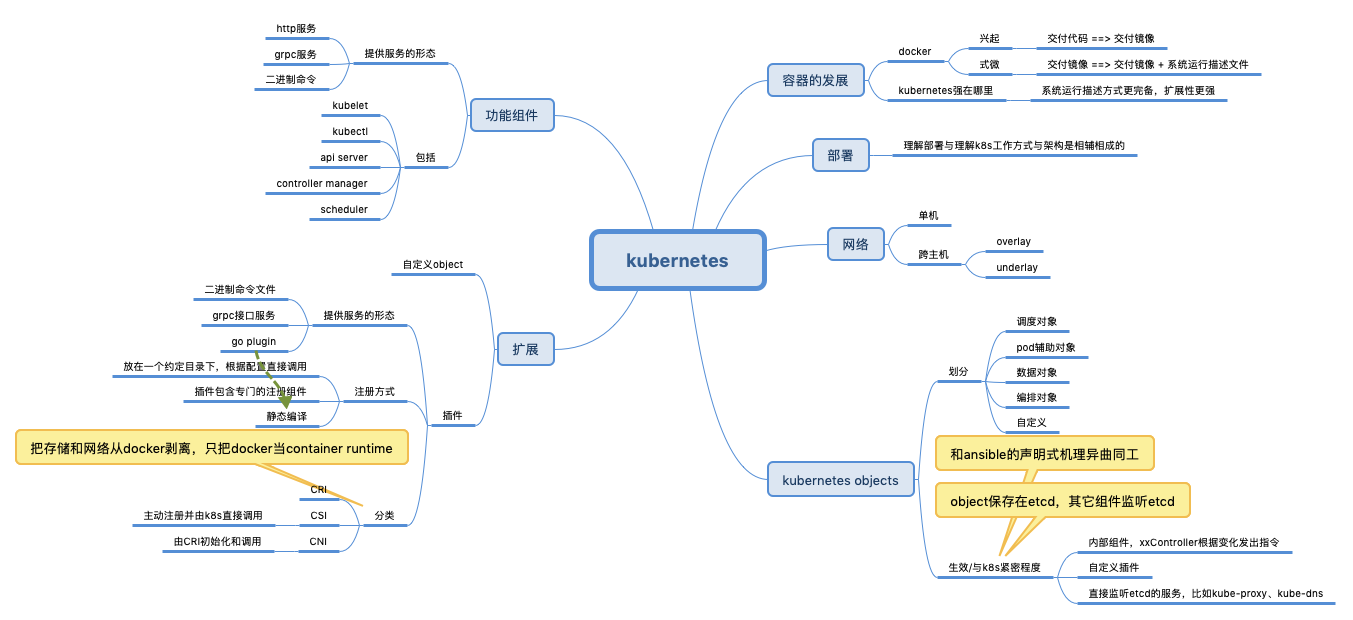
kubelet 源码分析:Garbage Collect gc 机制后面由 eviction 代替